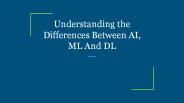Intelliprise PowerPoint PPT Presentations
All Time
Recommended
Data analytics and all its related processes, such as the integration, aggregation, storage and reporting of data, are fully or partially conducted in the cloud when talking about ‘cloud analytics’.
| PowerPoint PPT presentation | free to download
Popular terms we often hear nowadays, artificial intelligence, machine learning and deep learning are all closely related, that much is true, but there are some important differences between them. Helping companies streamline their processes and make their systems more efficient, let’s look at the differences in a little more detail:
| PowerPoint PPT presentation | free to download
In the broadest sense of the word, analytics applies to all activities involving problem-solving using technology, and is typically divided into four categories along a continuum, comprised of descriptive analytics, diagnostic analytics, predictive analytics and prescriptive analytics.
| PowerPoint PPT presentation | free to download
Combining business analytics, data mining and visualization, tools, infrastructure and best practices, business intelligence (or BI) is vital for helping companies make informed and intelligent decisions that are based upon the relevant data. If your organization uses a comprehensive collection of data to drive positive change, eradicate any inefficiencies and adapt better, and quicker to changes in the market or supply chain, then you undoubtedly possess modern business intelligence.
| PowerPoint PPT presentation | free to download
Shaking up markets and creating questions around which industries will hit the mark, and which will fall below target, technological advancement is both exciting and worrying; exciting for those companies prepared to experiment with new tech, and worrying for those who don’t have what it takes to keep up with the advancements.
| PowerPoint PPT presentation | free to download
Describing the large volume of both structured and unstructured data that businesses deal with every day, big data is useful for more than merely its volume of information, and is better known for helping businesses analyze data to make more informed and strategic, decisions and moves. And no matter what the size of your business, big data can be immensely helpful in a whole host of ways.
| PowerPoint PPT presentation | free to download






